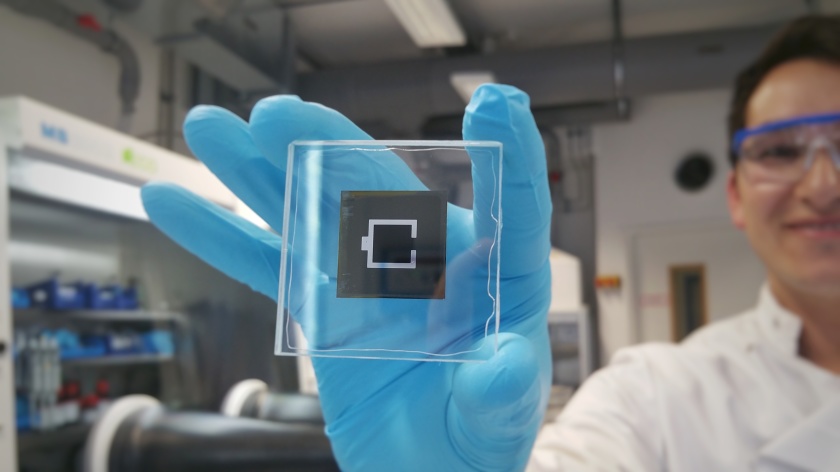Innovation Lab HySPRINT
Behind the scene: Towards the highest efficiencies with perovskite solar cells
01.12.2019
The way from the first scientific activities to today’s perovskite lab within the Helmholtz Innovation Lab HySPRINT
Prof. Dr. Steve Albrecht is the head of the Young Investigator Group (YIG) “Perovskite Tandem Solar Cells” working within the framework of the Helmholtz Innovation Lab “HySPRINT”. 4 years ago, when he started at Helmholtz-Zentrum Berlin (HZB) as a Postdoc, only a couple of scientists conducted research in the topic of perovskite solar cells. Since then a lot has changed. The perovskite research has attracted a lot of interest and has grown rapidly. Today, his team consists of 11 researchers with more scientists to be employed soon. To accommodate the perovskite researchers at HZB and to foster industry collaborations, Albrecht has successfully established the perovskite HySPRINT lab. It is now fully equipped for world-class perovskite research and is shared between 2 other YIGs, led by Dr. Eva Unger and Dr. Antonio Abate.
Albrecht’s group is in charge of the HySPRINT subproject “Perovskite/Silicon Tandem solar cells” and focuses on different types of perovskite absorber materials and contact layers for application in tandem solar cells, i.e. a combination of perovskite top-cells prepared on top of a wafer-based silicon bottom cells. Due to easy processing of the perovskite top-cell, the tandem technology can be implemented into existing silicon solar cell fabrication lines.
He and his group members are mainly working on the improvement of tandem solar cell efficiency. The first Perovskite/Si monolithic tandem devices presented in the beginning of 2015 had a power conversion efficiency (PCE) of only 13.7%. Today, after almost 5 years, Albrecht says: “Our group was one of the first to announce and, more importantly, certify the 25% PCE by independent tests”. They have recently presented a new tandem device with an innovative foil on top that enhances light trapping. In this work, post-doc scientist from Albrecht’s group, Dr. Marko Jošt, published 25.5 % PCE i - the highest efficiency achieved for the monolithic tandem solar cell by a research institution. In addition, results obtained and presented by Albrecht’s PhD student Eike Köhnen (see image) at the 4th International Conference on Perovskite Solar Cells and Optoelectronics (PSCO) conference in Lausanne, Switzerland, showing an even higher yet unpublished efficiency of 26% for the tandem solar cells, were awarded by the poster prize ii.
Furthermore, Albrecht’s group is currently working on the realization of novel charge-selective contacts formed by self-assembled monolayers (SAMs). In collaboration with partners, Albrecht’s PhD candidate Amran Al-Ashouri has recently published a new generation of SAM molecules that show very interesting contact properties in perovskite solar cells. In the early stage of development, the group has realized an efficiency of 18% iii for a SAM-based device, which was recently improved to an impressive value over 21%.
The research team not only fabricates the tandem devices with high performance, but also analyses the solar cells in detail. They utilize various methods such as current voltage measurements, evaluation of external quantum efficiencies in different ranges of the spectrum – blue, green and red-infrared, as well as optical experiments and structural investigations. Especially important is the optical analysis by theoretical simulations, performed in collaboration with Dr. Klaus Jäger, a scientist from another HySPRINT subproject - “Nano-Imprint-Lithography, Surface Functionalisation and Sensors”. Using this approach, the group is also estimating one of the most important parameters for the industry and practical applications – the energy gain of the solar cell, i. e. how much energy can be realistically harvested per year.
Photovoltaics is a fast developing field. Every month different labs publish several new results on efficiencies and improvements all over the world. Albrecht’s group is auspiciously following this trend, sometimes going ahead of the others. The Young Investigator Group has strong collaborations within and outside HZB. For example, Albrecht is already actively working with the Competence Centre Thin-Film- and Nanotechnology for Photovoltaics Berlin (PVcomB). Participating in the HySPRINT project, researchers from the perovskite lab are looking forward to even more collaborations with industrial partners to pave the way for practical realizations of their outstanding scientific achievements.
Mariia A.
Dec. 2018

